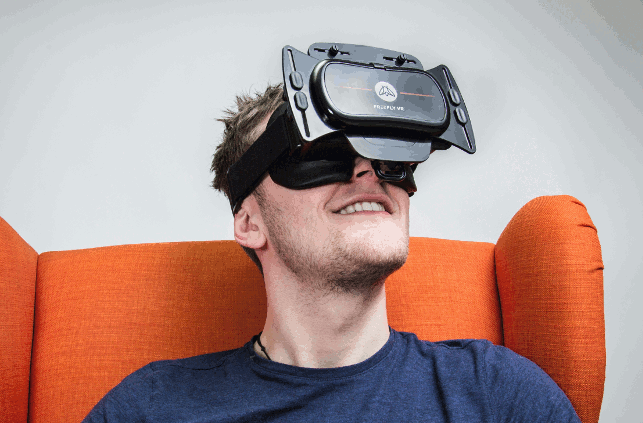
The Freefly VR transforms a user’s Android or iPhone 6 (including Plus) smartphone into a fully-fledged, highly immersive virtual reality headset
I magine this: instead of simply watching a music video on a screen, you find yourself immersed in the video’s 3D environment. You might, for instance, be transported to an Icelandic beach, taking in 360-degree views, as pop artist Björk serenades you.
This is the power of virtual reality (VR). All that’s needed to achieve such a personal and engaging experience of the music video is a smartphone and the Freefly VR headset. You simply slide the phone playing the video into the headset and you are instantly whisked away to that chilly shoreline.
In essence, VR creates for the user an immersive, computer-generated environment, based on the real world or an imagined one.
The VR headset market may already be pretty crowded, but newcomer Freefly, created by London based company Proteus VR, is looking to set itself apart by offering anyone, with any smartphone with a display between 4.7 inches and 6.1 inches, a wire-free, low-cost, yet high-quality VR experience.

During the design and development stage the Freefly VR headset went through 12 iterations with The Claw being the first through to the final design (above)
“Designing an ergonomic headset that could fit a wide range of face shapes and mobile phone sizes wasn’t easy,” admits Mark Little, head of design at Luma-iD, the London based product design consultancy responsible for the design and development of Freefly.
“We are really pleased with how it turned out as it took a long time and there were many challenges along the way.”
How it began
Luma-iD is a fairly new company, having been set up by Little and his business partner Luke Vos in 2013. Freefly was one of the first projects it undertook.
The partners were approached by Jonathan Tustain, a London VR Meetup host and VR blogger, with the brief of creating a 3D-printed VR phone adapter for his LG Nexus 5 mobile phone. This, Tustain envisaged, would provide the subject of a blog post on the feasibility of 3D printing VR headsets.
“We were basically commissioned [to work for] so many hours on the project, but we ended up spending double the hours, because we enjoyed it so much,” says Little.
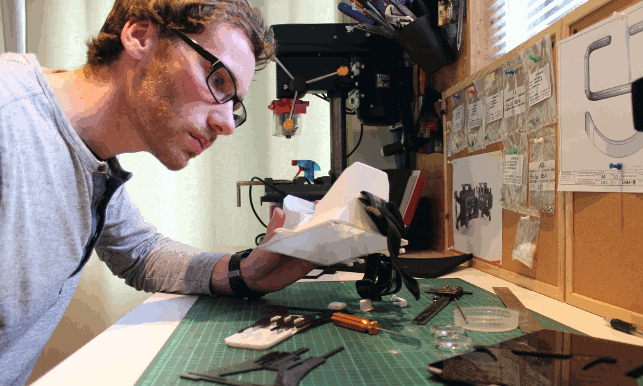
Mark Little, Luma-iD’s head of design, with one of the early 3D prints created by 3DprintUK. At the start of the project the design team also looked into water-cutting carbon fibre sheets
So, when Luma-iD came to deliver to Tustain the 3D print of their proposed design, which they had nicknamed ‘The Claw’, they enquired as to whether he’d be interested in working together with them to take the project further. He agreed and a longer-term partnership got underway.
But after scrutinising various mobile phones, the partners decided that the headset should be designed around a tablet device instead. “At the time, tablets such as the 7-inch LG Nexus 7 were really popular. They also offered a higher performance over mobiles, as they rendered the frames a lot quicker,” explains Little.
Having sketched out a few ideas, Little very quickly jumped into SolidWorks to model the concepts. In total, there were 12 iterations during the concept development stage: each one involved modelling the idea on the computer, having it 3D printed, physically checking and testing it, and then turning back to the computer to make further changes.
“We started off with The Claw, which was crazy and angular, and then we tried to find an identity for the device. We wanted to integrate softer lines and make it a bit different to competitor devices, which are typically heavy, chunky and game-y looking,” adds Little.
Advantages of 3D printing
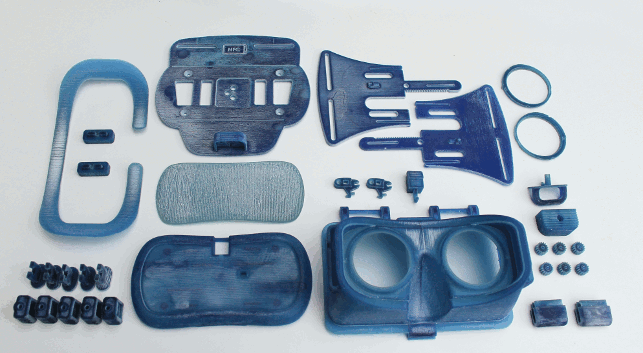
The very high resolution resin print by Impossible Creations allowed Luma-iD to check the functions of the Freefly in more detail before embarking on tooling
For most of its 3D printing needs, Luma-iD utilised the services of 3D printing bureau 3DprintUK, which was conveniently located directly next door to its own office.
The nylon powder prototypes could be available from 3DprintUK’s EOS selective laser sintering machine in as little as 24 hours, drastically speeding up development.
During the early exploration phase, Luma-iD also experimented with the use of different materials and construction techniques. For instance, to save costs on tooling and because tablets have such a large surface area, they considered laser-cutting the faceplate pieces from flat sheets of acrylic.
They also considered water-cutting carbon fibre sheets, as this would allow for a very stiff and lightweight design, but this idea was dismissed due to the environmental hazards and high costs associated with working with this material.
“We really explored a lot of ideas at the start to see what would work best. It certainly was quite a challenge finding our way through all of these developments,” says Little.
Three or four iterations down the line, the project took a dramatic diversion: the designers decided to switch back to mobile phones, as tablets were proving just too large and cumbersome.
Also, in the short time since they had started the project, phone technology had advanced in a big way. Not only were batteries now lighter, but also screens were larger and offered higher resolutions.
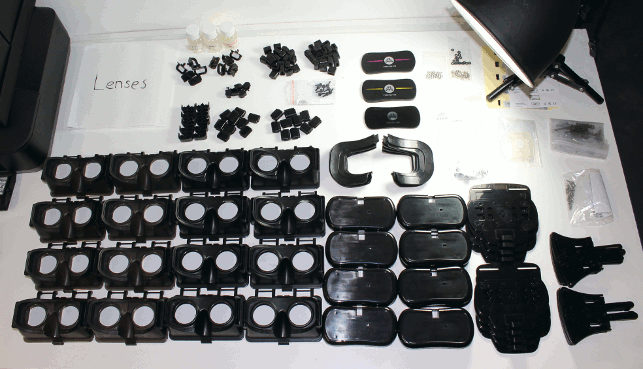
The Luma-iD design team visited the manufacturing partners in China to oversee the first production run
“In almost everything I have done, the goal posts have been fairly fixed. There are always changes in design, but I have never known anything [like] the two years of developing this product: for phones to get increasingly better and for our original idea of tablets to get increasingly worse and less popular.”
“It was difficult to predict, and it seems obvious now, but back when we started out, we weren’t sure if phones would be up to the task of delivering the kind of performance that was needed for good VR,” says Little.
Challenges to overcome
The challenge now was not only accommodating different mobile phone sizes and thicknesses into the design, but also working out how to clamp them in place for easy insertion and removal by the user.
“Coupled with this, we also wanted to give users quick access to the touchscreen. Loading the phone from the side or the top would make it difficult to touch the screen and would involve sliding the phone completely out of the device,” comments Little.
The solution they came up with is a simple latch on the bottom of the device, which allows the headset to be opened while the phone stays clamped in place via a dual springloaded set of ‘wings’.
This allows the user to quickly choose a different app or restart the experience for a new user, while the device is still being worn. When the device needs to be removed, the dual ‘wings’ spring open at the click of a button.
Another challenge was accommodating the product to fit many different head sizes and eye distances. Again, 3D printing proved invaluable in honing the perfect fit for the majority of people.
Full steam ahead
Having fine-tuned the design to create a product they were happy with, Luma-iD and Tustain decided to form a separate company, Proteus VR Labs, to market the product and take it into production.
As part of this process, they had to come up with a name for the device, as well as create branding and a logo.
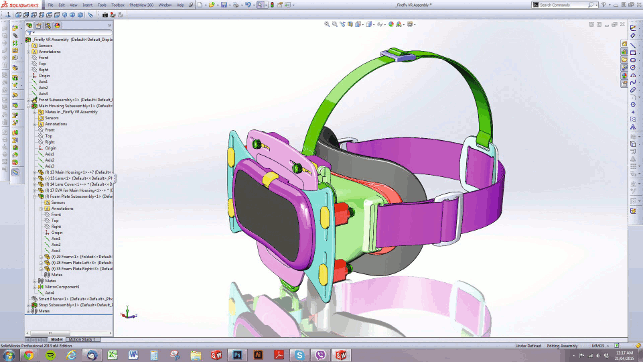
The Freefly VR was modelled in SolidWorks. Here is a screenshot of the final iteration of the product
“We wanted to create something that was a little bit different,” says Little. “There are a lot of very techie names in the VR world at the moment, some of which you can’t even pronounce, so we wanted to create something that conveys freedom and one of our main unique selling points of being wire-free.” The name ‘Freefly’, they decided, got that message across well.
With investors on board, Proteus VR Labs could now progress to tooling.
In October 2014, Little visited a manufacturing partner in China, in order to review the ‘first-off tools’ (typically, a die or mould) and work through any minor issues. What he found there, however, was a major problem.
Essentially, foam was being used around the eye area on the headset, to act as cushioning. Between this foam and the main housing was a rubber material. It had been decided that this would be fixed in place either with glue or with 3M tape, depending on how the manufactured parts came out.
“We built all these jigs to hold the foam in place and it was just a nightmare. The quality of the finish was awful, everything was all over the place and it just didn’t work,” admits Little.
“We were trying to bend a piece of acrylic under tension and then after gluing it, it felt like if we dropped it, it would explode and shatter. It was just an absolute disaster.”
He came back to the UK disappointed. Although he’d cracked a lot of smaller issues and the rest of the product was working well, a solution for the problem with the foam was desperately needed.
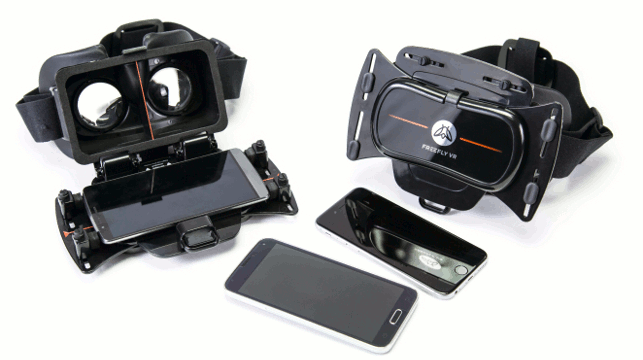
The Freefly VR converts phones with screen sizes between 4.7 inches and 6.1 inches into wide field of view (FOV) virtual reality headsets via a springloaded, dual-wing mechanism
Having researched various headphone devices, the partners struck on the idea of using faux leather. This material, which has a foam lining, could be wrapped over a new curved ABS-based plate and then easily glued to the main housing.
“The faux leather feels like a pair of headphones on your face — much more comfortable and it looks really cool.”
“We are really pleased with how it turned out in the end, despite adding more time into the process. But that’s just the way it goes sometimes,” says Little.
A new look
This use of faux leather also prompted the designers to change some of the product’s aesthetics. Originally, they had gone for a Storm Trooper-inspired black and white colour scheme, but following the change of materials, they instead opted for a more understated black and orange scheme instead.
Before tooling for a second time, a very high-resolution resin 3D print was created by Essex-based prototyping bureau, Impossible Creations.
“The nylon prints were fantastic, but they were not quite there when it came to the final fit and finish of everything.
So we did a 0.01 resolution print, which gave us an idea of how it would all fit together, right down to the little bits of play in between the components,” says Little.
Little visited the Chinese manufacturer again in January 2015 to oversee the first production run. Despite the slight delay and increased cost to the project, his view is that they’ve ended up with a much better product.
Launch and availabilty
The Freefly VR headset was officially launched in mid-April 2015, with immediate availability on Amazon.
“To get the product onto Amazon took up just as much energy as some of the tooling and design issues,” confesses Little.
“But this is what has made this project very interesting. Usually our role is pretty defined. Either we produce prototypes for companies, or we go right up to production and have a delivery date.
This was the first time that we’ve gone beyond that and had a role in app development, packaging design, creating press materials, working with distribution and learning how to use Google Analytics for the product’s website.”
One of the first showcases for the Freefly was to offer users an immersive experience inside Icelandic pop artist Björk’s new music video for her song, ‘Stonemilker’. As part of the track’s launch in March, visitors to Rough Trade music shops in London and New York were given the chance to try the Freefly headset and experience first-hand the 3D representation of an Icelandic beach where Björk sang to them.
Little knows that there is still a long journey ahead in terms of getting customers interested in the product and building a healthy sales pipeline. However, he’s delighted with what has been achieved so far.
“It’s been a hell of a ride, I must admit, but for us as a team, we are so proud of what we have produced. It’s a very satisfying feeling to see the end result of something that has gone through so many steps.
“We really put everything into it and solved a lot of problems. I think we deserve a holiday now,” he smiles. 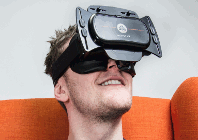
Developing Freefly, the virtual reality headset that transforms a standard smartphone
Default






